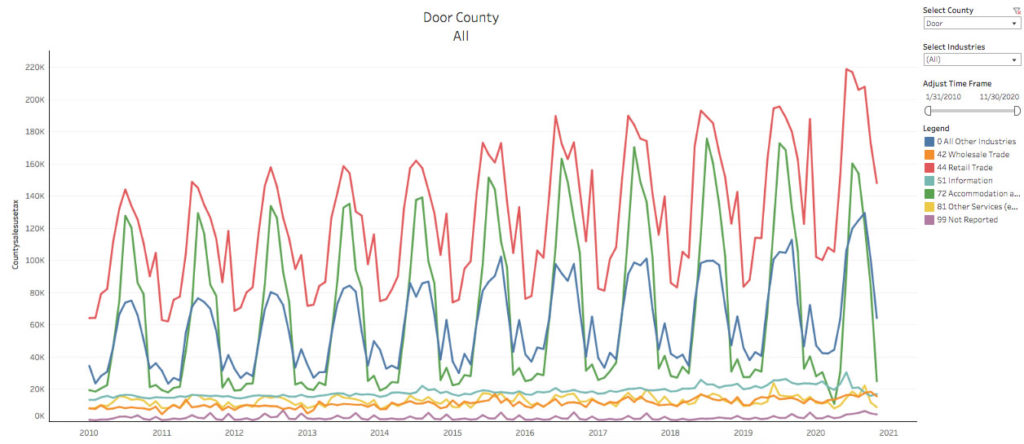County Sales Tax Collection Hits New High in 2020
- Share
- Tweet
- Pin
- Share
At this point, it seems unlikely that there are any appropriate (or even inappropriate) adjectives that have not already been applied to the last calendar year. And yet, the year 2020 can still offer up a few surprises.
Consider this: Last year (yes, 2020) Door County generated more sales-tax revenue than in any year prior. And the county accomplished this despite a stay-at-home order, reduced occupancy in restaurants and resorts, and all the other complications that occurred to limit economic activity during the course of the year.

The chart shows the sales tax collected and distributed back to the county in 2020 and 2019. As you look at these numbers, it is important to keep in mind one drawback to the state’s sales-tax reporting system: All sales tax collected in any given month is reported in that same month.
The reason this is a drawback is twofold. First, different businesses have different reporting and payment deadlines: Some pay monthly; some pay quarterly; and some pay annually, which skews the numbers for any given month. The second drawback is that any collected delinquent taxes are applied to the month within which those payments were received, rather than back-credited to the time when they were actually supposed to be paid.
Despite these drawbacks, the sales-tax numbers still provide one of the best overviews of Door County’s economic activity. As you look at the chart, you will notice something interesting if you break the year into thirds. For the first third of the year, every month in 2020 was up over 2019. For the second third of 2020, every month was down compared to 2019. And for the final third of 2020, we were up two months and down two months, but up overall compared to 2019.
So when you do all the math, the county collected $151,185.43 more sales tax last year than it did in 2019, which is a 3.5 percent increase. Thus, last year’s sales (the amount spent that was subject to sales tax) were $30,237,086 more than 2019.
As astounding as those numbers are, they become even more remarkable when you realize that the sales tax collected by lodging and restaurants last year in the county was the lowest it has been since 2016.

The graph shows preliminary sales tax collected by industry sector from 2010 through November of last year. The first thing you notice is how the seasonality of our economy is clearly demonstrated.
The green line shows the Accommodations and Food Service sector. This sector was, unsurprisingly, very weak in 2020, which saw its first decline during the past decade. The peak month last year (as in most years) was July, with a total $160,101 in sales-tax collections. Compare that to the peak of 2019, also July, with a total of $172,623.
And by the way, in case you were wondering about that steep downward spike for the Accommodations and Food Service sector in 2020, that was in April, with a total of just $10,831.
So how did we make up for the shortfall in the Accommodations and Food Service sector? With record-setting performances from both the All Other Industries sector (the blue line) and particularly the Retail Trade sector (the red line).
The peak on the graph for All Other Industries occurred in July of both 2019 and 2020. The total sales tax collected by this sector in 2019 was $112,756, but in 2020, the total was $121,516, or an increase of 7.8 percent. That translates to a $1,752,000 increase in spending within this sector.
The Retail Trade increase was even more dramatic. This sector’s peak was in July of 2019, with a sales-tax total of $195,467. This past year, the peak was in June – though July was close behind – with a sales-tax total of $218,689. So last year saw a remarkable 11.9 percent increase in the Retail Trade sector at peak, which translates to a $4,644,400 increase in spending.
Obviously, retail stores could more readily adapt to the pandemic by emphasizing online shopping. If they already had a strong web presence, they stressed the convenience and safety of shopping with them online; if they didn’t have a strong web presence, they devoted time and effort to ramping up that presence. In both instances, the individual retailers ended up stronger and more diversified.
Likewise, restaurants were forced to build up their takeout and curbside-pickup business, which, in the long run, will likely augment their bottom line. The shutdown and inside-dining limitations for restaurants, however, along with the occupancy restrictions that the lodging portion of this sector faced, were simply too much to result in anything other than a significant economic reduction.
With the new year come new hopes. We currently have two vaccines being administered, with more on the way. It seems likely, though, that it will be mid- to late summer before enough Americans will have been vaccinated for things to return to a more normal routine on the peninsula, so it may be challenging for Door County to equal or top last year’s sales-tax total.
But if the Retail Trade sector can equal last year’s performance and the Accommodations and Food Service sector can rebound somewhat, we will almost certainly see our sales-tax distribution continue to climb.
